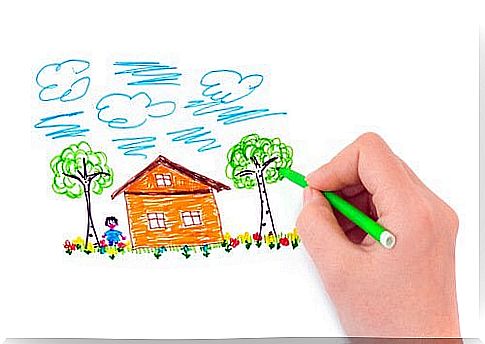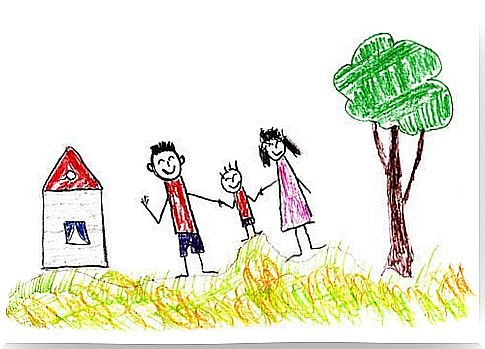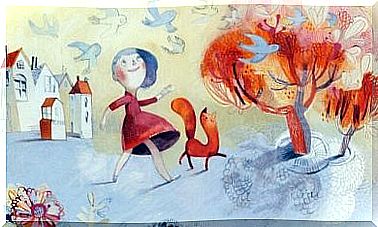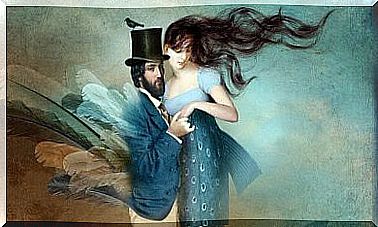House, Tree, Person: The Personality Test (HTP)

Through this HTP test (House-Tree-Person in English: House-Tree-Person), we can analyze certain personality traits, which areas are in conflict in our interior, the feelings we have and the projection of ourselves.
That is to say, what we consider to be proper to ourselves and what we situate outside of ourselves.
This personality test may seem like a piece of cake, but it also helps adults.
It is particularly developed in clinics, during psychological consultations or in psychoeducational schools.
What is the personality test?
In order to perform this test, people are asked to draw a house, a tree and a person on a piece of paper. This is what the acronym means in English: House, Tree and Person.
This test claims to show which are the most common conflicts and the most “hidden” in our interior.
Moreover, thanks to the drawings of these simple everyday objects, the one who analyzes can verify elements of the personality of the individual in question.
Even if we don’t realize it, drawing a house, a tree, and a person brings out things that we keep in our subconscious for different reasons.

It is not necessary to be Picasso or Dali to pass this test, since it is a question of finding what are the keys that the drawing gives.
What can he communicate? Concretely, it is used to express the “me” in connection with the family environment (such as a house or a tree) and close people.
The two phases of the HTP test
The study goes beyond simply drawing a house with a tree and a person next to it. This is why it should not be taken lightly.
First (the non-verbal and creative moment), we ask the analysand to draw these 3 elements.
It is likely that the expert suggests that he draw in the most natural way possible, forgetting as much as possible the context in which he finds himself and the subsequent analysis of the drawing.
When the person draws, the analyst takes the opportunity to look at his attitudes, his words and everything that he shows.
It can be frustration, nervousness, joy etc. Once the task is complete, it is time for the second step and the phase where a story is told using the three main tenses (past, present and future).
Another option, also very frequent in the HTP test: answer a series of questions, already established in advance by the specialist.
This serves to motivate people who have difficulty expressing themselves or children who do not yet have the ability to craft a story or tale.
How, when and where to do the HTP test
Note that this test is designed for people from 8 years old and that there is no maximum age to do it.
This means that anyone can start drawing a tree and a person and then be analyzed.
Perhaps it seems a little surprising for adults to consult an analyst and ask him to draw in the middle of the session, but the results obtained are very interesting.
To be able to fully benefit from this test, it is important to be in a quiet place, free from distractions.
The office or the cabinet are ideal because they also bring privacy. The analyst must also have all the necessary materials: sheets, pencils and eraser.

It is allowed to erase, but always taking into account the attitude that one takes in doing this: if once the drawing is finished, one decides to erase everything, it is not the same as d ” remove part of a line that you want to improve.
The HTP test takes approximately half an hour to an hour, depending on how long the patient takes to draw and tell the story.
Of course, it will also depend on the predisposition he has and whether the analyst has decided to ask some questions at the end of the test.
What is the HTP test used for?
The logic is simple. The test is based on the belief that through drawings one can express many feelings, whether past or present, as well as future desires.
Each image means a different thing: the projected house evokes the family situation of the present, the tree is the deepest and most inner concept of us and the person is a kind of self-portrait which includes our consciousness and our mechanisms. defense.
It is also necessary to analyze the place of each object on the sheet. For example, if one draws very close to the upper edge, the drawing is related to dreams and imagination, and in the lower part – to the material.
What is on the right expresses the link to the future, in the center to the present and on the left to the past.
We assess the size of each element, the layout (which can be firm or fragile) and clarity. It is also very interesting to understand that every part of the house, the tree and the person has meanings.
We will not tell you what each of them means so that you are not trapped before taking the test, but to give you a rough interpretation: the roof of the house represents the spiritual and the intellectual, the trunk of the tree the support of life and the hands of the person the emotional plane.
In this test, like the projection tests, the quality and information we get will depend on the attitude we face when drawing or constructing a story, but also on the skill of the analyst to differentiate what is important and what is not.









